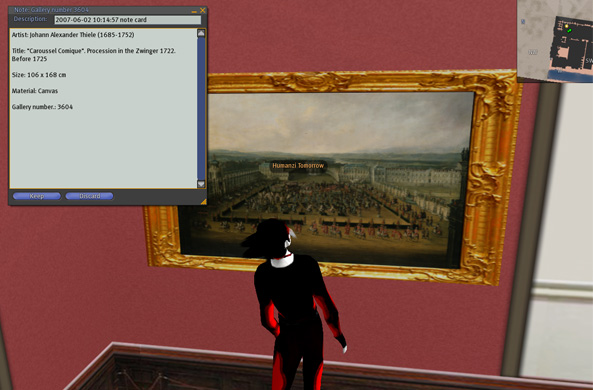Rhizome.org (part of the New Museum of Contemporary Art) is an online community devoted to the merging of art with technology. Their ArtBase is an archive of works that "employ materials including software, code, websites, moving image, games and browsers to aesthetic and critical ends." Rhizome.org Mission Statement - Rhizome.org is an online platform for the global new media art community. Our programs support the creation, presentation, discussion and preservation of contemporary art that uses new technologies in significant ways. We foster innovation and inclusiveness in everything we do.
Music and Video and iPods, Oh My!
On August 4th, the National Symphony Orchestra in Washington, DC, performed a concert entitled "Fantastic Planet" which combined classical music (of course) and more modern elements, such as video projections and....iPods? Prior to the show, NSO conductor Emil de Cou had recorded a commentary track that offered insights into the music of the evening. Pieces of history, trivia, and background that concert-goers eager to experiment could download to their iPods (or other MP3 players) and listen to during the live performance.
"I thought it would be neat to have the conductor being your seatmate, whispering into your ear at key moments," Emil de Cou said before the performance.
Reading the review on the Washington Post, it's obvious that the experiment achieved mixed results. Some folks had trouble syncing their iPods to the live music. Others found the commentary track distracting. With music, spoken words and video, all swirling around the brain at the same time, it's no wonder. According the Stephen Brookes, "Two minutes into the opening piece I quietly slid off my headphones, and by intermission it was impossible to spot anyone still plugged in."
But the idea of commentary tracks for classical music is not a bad one. DVDs almost always have commentary tracks. But usually those tracks are switched on during a movie you have seen countless times and know the plot, characters and dialogue stone-cold; so, it becomes quite easy to concentrate on the commentary and the movie at the same time. I doubt if many in the audience on August 4th knew Vaughan Williams's "Serenade to Music" as well as I know every line in the "Princess Bride."
Also, in commentary tracks, syncing is vital. Especially if the track refers to something occurring at a specific moment. With live music, it is probably hard, if not impossible, to truly craft a commentary track that will sync up, because the beauty of live performance is the fact that it is live, and thus different every time.
Regardless of the evening's perceived success, kudos to the NSO for trying something new! If I lived in Washington, DC, I would have been there with my iPod in one ear, the music in the other, a smile on my face, and a big thumbs up to their creative experiment combining arts with technology.
speaking of tools
Here's a link to information about a giveaway by Members Only Software to one arts organization that will be selected on September 10.
Visit Dresden's Art Gallery in Second Life
Not everyone can afford a trip to Dresden, Germany, but now anyone with a computer and a Second Life account can visit the city's famous art gallery. In June, a digital version of the entire building - 37,700 square feet and 750 paintings - was launched in the 3-D virtual world of Second Life.
 My Second Life self viewing a painting in Dresden's gallery. (View Full Image)
My Second Life self viewing a painting in Dresden's gallery. (View Full Image)
Check out the full story and some images from WIRED.com.
Powered by ScribeFire.
Nominations
There's still time to nominate someone (including yourself) for the 2007 ArtsTech Award... Click here to read about the award and the nomination process.
ArtandCulture.com Joins Exhibitors
It is my pleasure to announce that ArtandCulture.com, a very cool Web site showcasing a wide array of artists and arts organizations, has joined the Technology in the Arts 2007 exhibitor fair. The preliminary plan is for the folks from ArtandCulture.com to set up an informational booth where artists can learn about the site, discuss the tool's many interactive features and future development plans and even add their own profiles.
Thank you in advance to ArtandCulture.com for taking part in our conference.
And can you think of a better Web address than that?
Technology in the Arts - not the only reason to visit Pittsburgh this fall
Voters chose Pittsburgh as the best destination for the arts among mid-sized cities in the June 2007 issue of American Style magazine. Visit their Web site by clicking here to read the full article. You won't want to miss any of the museums or performing arts venues this fall so plan to come early or stay late. Pittsburgh is also at the top of the list of "most livable cities" according to Places Rated Almanac.
Check out these and other accolades at http://kdka.com/local/local_file_116160520/
Don't just read about it, come see what all the buzz is about. Online registration opens soon...sign up to get the Early Bird rate!
I can hear what you're thinking . . .
French philosopher Rene Descartes is credited with the phrase “I think, therefore I am”; now, nearly four centuries later, a young British woman may have taken the idea one step further – I think, therefore I create art. Interactive artist Luciana Haill uses medical electroencephalogram, or EEG, monitors embedded in a Bluetooth-enabled sweatband to record her brain activity, and send the data to a computer that plays it back as audio. Since the human brain operates in the same frequency as sound waves (hertz), it's a relatively simple process to use software to convert the brain's raw data into a sound format. Haill has been honing her craft over the last 14 years, and she now uses Apple's OS X operating system to trigger digital samples in GarageBand with each type of neural activity.
Haill's music has been featured in new music festivals, including Cybersonica 2006 and the recently completed Future of Sound tour, but she hasn't yet brought her music stateside. To hear it for yourself, visit Luciana's MySpace page.
Ice Cream [remix]
With summer finally on its way, ice cream trucks around the country are revving their engines and turning up the loudspeaker. Tired of the familiar (annoying) theme songs, New Yorkers Jeffrey Lopez and Lauren Rosati decided holding an online remix competition to come up with a new tune. The winner of the Ice Cream Headache contest will have their new song played on a Mister Softee truck driving through New York's five boroughs during Memorial Day Weekend. The contest has already received more than 40 entries, including the quirky Balinese Softee by Nina Katchadourian (my personal favorite).
To enter the contest, e-mail your entry to info@suite405.com. But hurry before it melts -- all entries must be received by Friday, May 5th.
please consider voting for SITI's social web project by April 14th
I work for SITI Company (an ensemble theater company led by Anne Bogart) and with the help of Erika Block we are developing a project that uses social media to build, connect and strengthen our international community of students and audiences through the creation of SEE (SITI’s Extended Ensemble). Rooted in SITI's commitment to international collaboration and the fostering of young artists, SEE uses social media to connect a community of artists and audiences, using an ensemble theater context to bridge virtual and “real” worlds by developing an online tool that fosters collaboration. Erika describes it as, "exploring ways to turn online connections into face-to-face connections - a networking meeting, getting out the vote, getting audiences into theaters. And to turn face-to-face connections into online communities. Deepening the impact of a performance or a workshop by creating a space for dialogue, shared tips, questions and, ultimately, repeat attendance. This is the potential of these tools - a seamless loop of participation."
She also points out "The Howard Dean campaign and MoveOn are early examples. MySpace is tremendously effective for promoting music and spoken word concerts (and, increasingly, other events). Last year’s Los Angeles immigration protests by young people were organized online. Just the other day, Andrew Taylor wrote about Charles Leadbetter's new book We-Think, which suggests that our traditional view of how innovations enter the market -- special people in special places creating things that are pushed down the pipeline to passive and waiting consumers -- is no longer true, if it ever was. Rather, the traditional, corporate approach to creativity and innovation is decreasingly able to develop radical innovation, and spends much of its time stifling the innovation of talented and networked amateurs [and professionals, I'd add]."
One of the things that's most interesting about SEE is its potential to become a model for the performing arts field, encouraging peer-to-peer collaboration and invention.
SITI has submitted the proposal for support from the NetSquared community (division of Tech Soup), which was developed to spur responsible adoption of social web tools by social benefit organizations. 20 projects will be chosen for support through a membership voting process, and anyone with an interest in this work can join NetSquared, for free. (Apart from the opportunity to vote, you can participate in a great conversation and draw on a growing resource base.)
We'd love for you to vote for SEE, and you can find the full project description here. The link to vote is here. (you'll have to register on the site)






